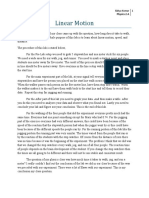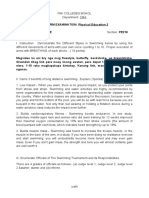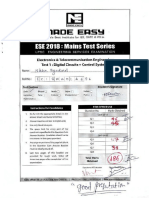0 ratings0% found this document useful (0 votes)
23 viewsCase Study2 2
Case Study2 2
Uploaded by
jagriti kumariThis case study aims to optimize the performance of a swimmer by finding the levels of significant factors that allow the swimmer to complete 25 meters in the least amount of time. The experimental factors considered are time of day (morning or afternoon), food intake (before or after swimming), and starting end of the pool (deep or far). The swimmer's style (free style) and water temperature are controlled. The response variable is the time taken to complete 25 meters. The study involves conducting experiments with different combinations of the factor levels and measuring the response variable.
Copyright:
© All Rights Reserved
Available Formats
Download as PDF, TXT or read online from Scribd
Case Study2 2
Case Study2 2
Uploaded by
jagriti kumari0 ratings0% found this document useful (0 votes)
23 views2 pagesThis case study aims to optimize the performance of a swimmer by finding the levels of significant factors that allow the swimmer to complete 25 meters in the least amount of time. The experimental factors considered are time of day (morning or afternoon), food intake (before or after swimming), and starting end of the pool (deep or far). The swimmer's style (free style) and water temperature are controlled. The response variable is the time taken to complete 25 meters. The study involves conducting experiments with different combinations of the factor levels and measuring the response variable.
Original Description:
nb
Copyright
© © All Rights Reserved
Available Formats
PDF, TXT or read online from Scribd
Share this document
Did you find this document useful?
Is this content inappropriate?
This case study aims to optimize the performance of a swimmer by finding the levels of significant factors that allow the swimmer to complete 25 meters in the least amount of time. The experimental factors considered are time of day (morning or afternoon), food intake (before or after swimming), and starting end of the pool (deep or far). The swimmer's style (free style) and water temperature are controlled. The response variable is the time taken to complete 25 meters. The study involves conducting experiments with different combinations of the factor levels and measuring the response variable.
Copyright:
© All Rights Reserved
Available Formats
Download as PDF, TXT or read online from Scribd
Download as pdf or txt
0 ratings0% found this document useful (0 votes)
23 views2 pagesCase Study2 2
Case Study2 2
Uploaded by
jagriti kumariThis case study aims to optimize the performance of a swimmer by finding the levels of significant factors that allow the swimmer to complete 25 meters in the least amount of time. The experimental factors considered are time of day (morning or afternoon), food intake (before or after swimming), and starting end of the pool (deep or far). The swimmer's style (free style) and water temperature are controlled. The response variable is the time taken to complete 25 meters. The study involves conducting experiments with different combinations of the factor levels and measuring the response variable.
Copyright:
© All Rights Reserved
Available Formats
Download as PDF, TXT or read online from Scribd
Download as pdf or txt
You are on page 1of 2
Module – 2
Case-study-2
Case- “Optimizing the Performance of a Swimmer”
Four times Olympic Champion Alex said “if you want to be a better swimmer, then
swim”. Then, “How should one practice?” would be the obvious next question. In this
study, we have tried to find an answer to this question by means of an experimental
analysis.
Performance of a swimmer is measured by the time taken by him to complete a particular
distance. Our objective was to find out what factors affect the performance of a
particular swimmer. We wanted to find the levels of these significant factors at which the
swimmer takes the least time to complete swimming a particular distance. For our
experiment, we chose the distance to be 25 meters. This particular distance of 25 meters
was chosen because the experiment was performed in the Terrace Apartments swimming
pool and the length of the pool was 25 meters. First of all, the pre-experimental analysis
was done. We stated our problem, choose the factors, their levels and ranges and we
selected the response (output) variable. After talking to a few people who practiced
swimming regularly, it was observed that time of the day (morning or afternoon)
influences performance of swimming. Taking food before or after swimming may also
influence performance. The swimming pool, obviously, has two ends. The end that is
deeper (about 8 meters usually) is called “Deep End” and the end that is not deep and is
usually just one meter deep is said to be the “Far End”. The swimmer may either choose
to start from either the deep end or the far end.
The swimmer may wear a swimming trunk and goggles for comfort or he may just wear
some casual shorts. But we are not interested in this factor. This factor is controlled
during experiment, and fixed. A heater controls the temperature of the water in the pool
and so the experiment is conducted when the swimmer swam in the water at a constant
temperature. The swimmer that we have selected can swim only in the “free style” way of
swimming. So the entire experiment is conducted when the swimmer swims in “Free
Style”. After noting down the time taken by the swimmer to swim for one end to the
other for any particular treatment combination, he was allowed to rest for 15 minutes to
regain the normal heart beat. Then the second reading was taken under same treatment
combination. The whole experiment is restricted for a particular swimmer under
investigation.
Can you recognize the problem statement, objective of the case study, identify
experimental (design) factors, control factors, nuisance factor, response variable, and
levels of all control factors?
You might also like
- Physical Education Borads Practical File Full ContentDocument29 pagesPhysical Education Borads Practical File Full ContentAfzal Hussain69% (203)
- UNIT - 6: Test & Measurement in Sports..!! Along-With Important QuestionsDocument68 pagesUNIT - 6: Test & Measurement in Sports..!! Along-With Important QuestionsMahima Famous100% (1)
- VW Audit Cheklist - EmptyDocument5 pagesVW Audit Cheklist - EmptySaipul IzaNo ratings yet
- Aerobic Anaerobic LabDocument13 pagesAerobic Anaerobic Labapi-350081950No ratings yet
- Aerobic Lab ReportDocument16 pagesAerobic Lab Reportapi-502029423No ratings yet
- Ped 307 Lesson 2Document10 pagesPed 307 Lesson 2api-269745950No ratings yet
- AngelDocument7 pagesAngelMaria Angelika BughaoNo ratings yet
- Reaction TimeDocument8 pagesReaction TimeQaqambaNo ratings yet
- Final Swimming Unit PlanDocument41 pagesFinal Swimming Unit PlanmountainthinairNo ratings yet
- Linear MotionDocument1 pageLinear MotionkartoonBOBNo ratings yet
- Class: XII Topic: Subject: Physical Education: 1.50 Meter DashDocument8 pagesClass: XII Topic: Subject: Physical Education: 1.50 Meter DashKunwar Devang Pratap SinghNo ratings yet
- Essentials of Deep DIving - Aharon SolomonsDocument10 pagesEssentials of Deep DIving - Aharon SolomonssurfsageNo ratings yet
- Wuz Good Essay RevisedDocument6 pagesWuz Good Essay Revisedapi-745294444No ratings yet
- Public Services Fitness TestingDocument11 pagesPublic Services Fitness TestingRepublicOfKorea100% (1)
- 00springccqDocument4 pages00springccqmanojjayakumarNo ratings yet
- Chapter 6 - Test and Measurement in SportsDocument18 pagesChapter 6 - Test and Measurement in SportsAnjana JaggiNo ratings yet
- PE Report RheaDocument34 pagesPE Report RheaSettie Nasraida DarpingNo ratings yet
- Physical Education For Written in Lab ManualDocument24 pagesPhysical Education For Written in Lab ManualAnirudh Pratap0% (1)
- Physical Education Lab Manual 2024-25Document16 pagesPhysical Education Lab Manual 2024-25Histo tropNo ratings yet
- Swimming Diagnostics 2Document25 pagesSwimming Diagnostics 2ScribdTranslationsNo ratings yet
- Unit 3 A03Document11 pagesUnit 3 A03RepublicOfKoreaNo ratings yet
- Preparation Tasks - Week 4Document5 pagesPreparation Tasks - Week 4Άγγελος ΧαβέλαςNo ratings yet
- Swimming - Powerpoint 2019 2020Document69 pagesSwimming - Powerpoint 2019 2020Alen Genesis Coronel100% (1)
- Activity 2Document6 pagesActivity 2Christine Joy LealNo ratings yet
- Kin 291 Final Lab ReportDocument12 pagesKin 291 Final Lab Reportapi-569001433No ratings yet
- Physical EducationDocument44 pagesPhysical EducationAditya Puri 10B 21No ratings yet
- Motor Fitness TestDocument23 pagesMotor Fitness Testdharmendra jhaNo ratings yet
- Physical EducationDocument44 pagesPhysical EducationHaniful AminNo ratings yet
- Swimming Powerpoint 2019 2020Document69 pagesSwimming Powerpoint 2019 2020Cresente galendezNo ratings yet
- Biology Labs - Food TestDocument11 pagesBiology Labs - Food TestJoy BoehmerNo ratings yet
- Gr.12 Test & MeasurementDocument5 pagesGr.12 Test & Measurementsaran.rayanbrosNo ratings yet
- SwimmingDocument4 pagesSwimmingNeighvestNo ratings yet
- Test and Measurement in Sports: Motor Fitness Test-AAHPERDocument5 pagesTest and Measurement in Sports: Motor Fitness Test-AAHPERVisakh A SNo ratings yet
- Les Cles de La Profondeur': The Essen Tials of Deep Divin GDocument11 pagesLes Cles de La Profondeur': The Essen Tials of Deep Divin GΚωστας ΜαυροςNo ratings yet
- Lesson 4-6Document13 pagesLesson 4-6Joana Polondaya CabreraNo ratings yet
- Six Minute Walk Test - Part 2: Nimisha B (MPT, Dyhe) Assisstant Professor Sacpms, MMC ModakkallurDocument20 pagesSix Minute Walk Test - Part 2: Nimisha B (MPT, Dyhe) Assisstant Professor Sacpms, MMC ModakkallurNimisha Balakrishnan100% (1)
- Performer 50Document19 pagesPerformer 50Priozky Pratama PurbaNo ratings yet
- Midterm Exam Pe 2Document3 pagesMidterm Exam Pe 2LabLab ChattoNo ratings yet
- How To Learn The Basics and Fundamentals of Swimming3Document25 pagesHow To Learn The Basics and Fundamentals of Swimming3api-252465763No ratings yet
- Stand 3 Artifact 1Document20 pagesStand 3 Artifact 1api-137719419No ratings yet
- 6mwt ProtocolDocument4 pages6mwt ProtocolpashaNo ratings yet
- 6mwt ProtocolDocument2 pages6mwt ProtocolΆγγελος ΧαβέλαςNo ratings yet
- Test Mesurement in SportsDocument5 pagesTest Mesurement in SportsVisakh A SNo ratings yet
- Physical Fitness TestDocument11 pagesPhysical Fitness TestNichole AbonalNo ratings yet
- PE Chapter - 6Document72 pagesPE Chapter - 6Punjabi Bass BoostedNo ratings yet
- 8 o 0 Kluv Awwthrsqu GQW JDocument8 pages8 o 0 Kluv Awwthrsqu GQW JDhruv RajputNo ratings yet
- TestDocument19 pagesTestVijay Luxmi TripathiNo ratings yet
- Heart Rate Design PracticalDocument13 pagesHeart Rate Design PracticalMary Elizabeth ValmoresNo ratings yet
- AZARCON BRYAN PE FinalOutputDocument13 pagesAZARCON BRYAN PE FinalOutputdasij3880No ratings yet
- 2 Swim Sets To Help Increase Your Speed in The Water PDFDocument3 pages2 Swim Sets To Help Increase Your Speed in The Water PDFShashankNo ratings yet
- Compare and Con-WPS OfficeDocument2 pagesCompare and Con-WPS Officeoi oi oi matte matteNo ratings yet
- Reflex Reaction LabDocument4 pagesReflex Reaction LabnoorNo ratings yet
- Mythbusters Scientific Method WSDocument4 pagesMythbusters Scientific Method WSokubaytekle27No ratings yet
- AO3 Public Services: WWW - Google.co - Uk/imagesDocument7 pagesAO3 Public Services: WWW - Google.co - Uk/imagesrhysmorris007No ratings yet
- Aapher Physical Fitness Test: S.No Test Items ProposeDocument15 pagesAapher Physical Fitness Test: S.No Test Items ProposeS. VeeravelNo ratings yet
- Lesson Plan Element 4Document4 pagesLesson Plan Element 4api-239462282No ratings yet
- Junatan A. Abiner Jr. BSMT 1-11 PE 1 Basic Swimming Teacher: Glenn Danos Lesson 1 Activity 1.1Document9 pagesJunatan A. Abiner Jr. BSMT 1-11 PE 1 Basic Swimming Teacher: Glenn Danos Lesson 1 Activity 1.1Junatan Jr AbinerNo ratings yet
- Volley Ball FileDocument35 pagesVolley Ball FileOm Hari ShuklaNo ratings yet
- Class 12 P.H.E ProjectDocument21 pagesClass 12 P.H.E ProjectAkash80% (5)
- Rainy Day Pedometer Scavenger Hunt Worksheet NEWDocument4 pagesRainy Day Pedometer Scavenger Hunt Worksheet NEWluckyklc12No ratings yet
- Length Tension Testing Book 1, Lower Quadrant: A Workbook of Manual Therapy TechniquesFrom EverandLength Tension Testing Book 1, Lower Quadrant: A Workbook of Manual Therapy TechniquesRating: 3.5 out of 5 stars3.5/5 (3)
- Module II. Process Quality Improvement Lecture - 1 Why Process Quality Improvement Is Important?Document2 pagesModule II. Process Quality Improvement Lecture - 1 Why Process Quality Improvement Is Important?jagriti kumariNo ratings yet
- It Ic Ir I3t L.A Testing Report of Gss SabourDocument2 pagesIt Ic Ir I3t L.A Testing Report of Gss Sabourjagriti kumariNo ratings yet
- Rainage Ystem: Geography - Part IDocument11 pagesRainage Ystem: Geography - Part Ijagriti kumariNo ratings yet
- Instructions: 1. Answers Should Be Written in A4 Size Papers OnlyDocument71 pagesInstructions: 1. Answers Should Be Written in A4 Size Papers Onlyjagriti kumariNo ratings yet
- Name Transfer FormDocument1 pageName Transfer Formjagriti kumariNo ratings yet
- Tutorial 11Document3 pagesTutorial 11jagriti kumariNo ratings yet
- 4 Nisha-Byadwal Ec 2343Document35 pages4 Nisha-Byadwal Ec 2343jagriti kumari100% (1)
- Module II-Lec3 2Document4 pagesModule II-Lec3 2jagriti kumariNo ratings yet
- EE311 EE311 Introduction To Semiconductor Introduction To Semiconductor DevicesDocument24 pagesEE311 EE311 Introduction To Semiconductor Introduction To Semiconductor Devicesjagriti kumariNo ratings yet
- Information On ProjectsDocument2 pagesInformation On Projectsjagriti kumariNo ratings yet
- Ece2610 Chap3Document46 pagesEce2610 Chap3jagriti kumariNo ratings yet
- Substation Line 132/33 KV Jamalpur, Bihar Outgoing Feeder 025Document2 pagesSubstation Line 132/33 KV Jamalpur, Bihar Outgoing Feeder 025jagriti kumariNo ratings yet
- #18 Dynamic Memory AllocationDocument5 pages#18 Dynamic Memory Allocationjagriti kumariNo ratings yet
- EE311 - 15 - L10 - DopingDocument13 pagesEE311 - 15 - L10 - Dopingjagriti kumariNo ratings yet
- EE311 L8 Energy Band Part1Document12 pagesEE311 L8 Energy Band Part1jagriti kumariNo ratings yet
- Civil Engineer: M. Mekni El HadjDocument5 pagesCivil Engineer: M. Mekni El HadjBilel Bechiri0% (2)
- UTSP Assignment 1Document10 pagesUTSP Assignment 1Dheeraj SawantNo ratings yet
- ABB Wireless Networks - Overview (Kener Kalilio)Document43 pagesABB Wireless Networks - Overview (Kener Kalilio)nelsitotovarNo ratings yet
- 05-28-17 Field Report The Emerald Plunge With NarrativeDocument21 pages05-28-17 Field Report The Emerald Plunge With NarrativeBayAreaNewsGroupNo ratings yet
- 23 Directly and Inversely ProportionalDocument6 pages23 Directly and Inversely Proportionalapi-299265916No ratings yet
- Undesa PD 2022 Policy Brief Population GrowthDocument4 pagesUndesa PD 2022 Policy Brief Population GrowthHILLARY FRANCIS SHENJERENo ratings yet
- Instant Download Animal Behavior 11th Edition John Alcock PDF All ChapterDocument64 pagesInstant Download Animal Behavior 11th Edition John Alcock PDF All Chapterdavelljazy100% (4)
- Pioneer VSX 924 KDocument121 pagesPioneer VSX 924 KenergiculNo ratings yet
- External Prestressing in Bridges - 201-468Document268 pagesExternal Prestressing in Bridges - 201-468Alok vermaNo ratings yet
- An African Treasury ManDocument232 pagesAn African Treasury ManRobbieKnuthNo ratings yet
- KOBELCO Reference Plant 171102Document23 pagesKOBELCO Reference Plant 171102Bảo BáchNo ratings yet
- Unit - 5 Electric DipolesDocument9 pagesUnit - 5 Electric DipolesELMURNo ratings yet
- AIIMS Solved Paper 2014Document51 pagesAIIMS Solved Paper 2014Débàshis DashNo ratings yet
- TOEFL Test Structure - 2023Document11 pagesTOEFL Test Structure - 2023Rohadhatul AtikaNo ratings yet
- Deep Foundations PDFDocument15 pagesDeep Foundations PDFGaddam Padmaja ReddyNo ratings yet
- Hybrid Electric VehicleDocument23 pagesHybrid Electric VehicleshwetajhambNo ratings yet
- Eurotron-Presentation Site - Mai 2012Document20 pagesEurotron-Presentation Site - Mai 2012EnergiemediaNo ratings yet
- Mason Wendler - Rough Draft Senior Project EssayDocument11 pagesMason Wendler - Rough Draft Senior Project Essaymason.wendlerNo ratings yet
- Test Paper - Carbon and Its CompoundsDocument1 pageTest Paper - Carbon and Its CompoundsJagpreet SinghNo ratings yet
- Letran de Davao, Inc.: High School DepartmentDocument1 pageLetran de Davao, Inc.: High School DepartmentappleNo ratings yet
- Design and Fabrication of Film Frame1Document35 pagesDesign and Fabrication of Film Frame1Nitin SakpalNo ratings yet
- Kolos Et Les Quatre Voleurs TEXTEDocument4 pagesKolos Et Les Quatre Voleurs TEXTEser123No ratings yet
- Section 7.9 Square Root Functions and InequalitiesDocument3 pagesSection 7.9 Square Root Functions and InequalitieskcarveyNo ratings yet
- Design and Modal Analysis of Gravity Dams by AnsysDocument14 pagesDesign and Modal Analysis of Gravity Dams by AnsyslucasNo ratings yet
- VeriVide CAC LED Datasheet 2019Document2 pagesVeriVide CAC LED Datasheet 2019Arthur ThiesenNo ratings yet
- Human Flourishing in Science and TechnologyDocument84 pagesHuman Flourishing in Science and TechnologyAndromeda Galaxy100% (2)
- Carpigiani Error CodesDocument2 pagesCarpigiani Error CodesGbenga FowobiNo ratings yet
- 3330Document15 pages3330Sarmed IbrahimNo ratings yet
- DMADocument16 pagesDMALavish Garg0% (1)








































































































